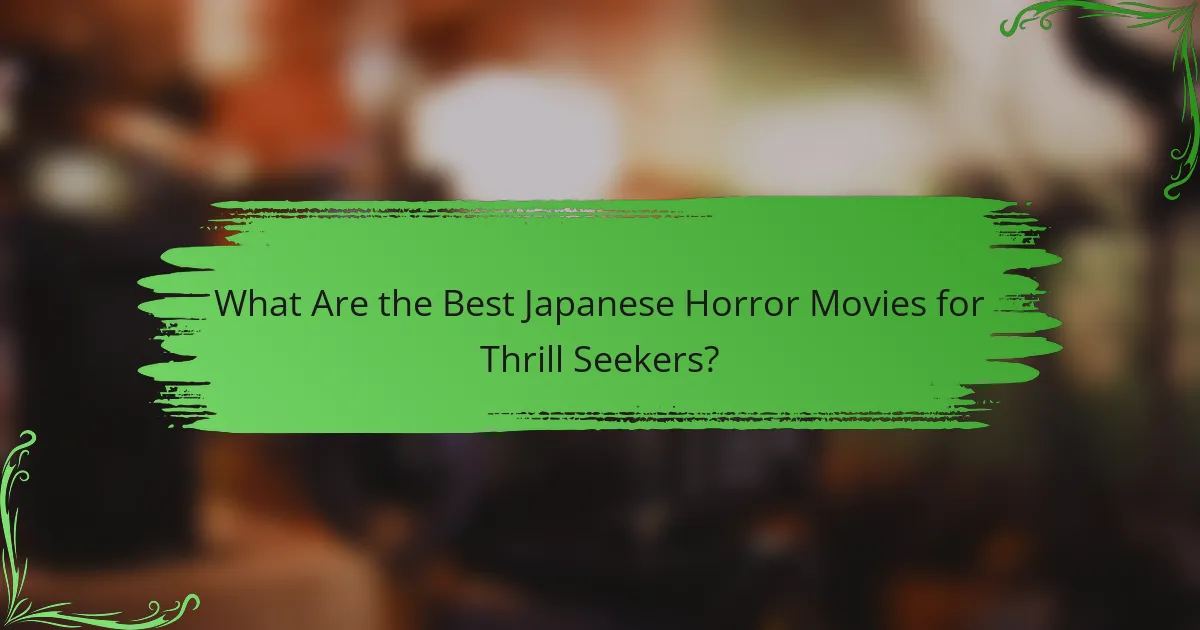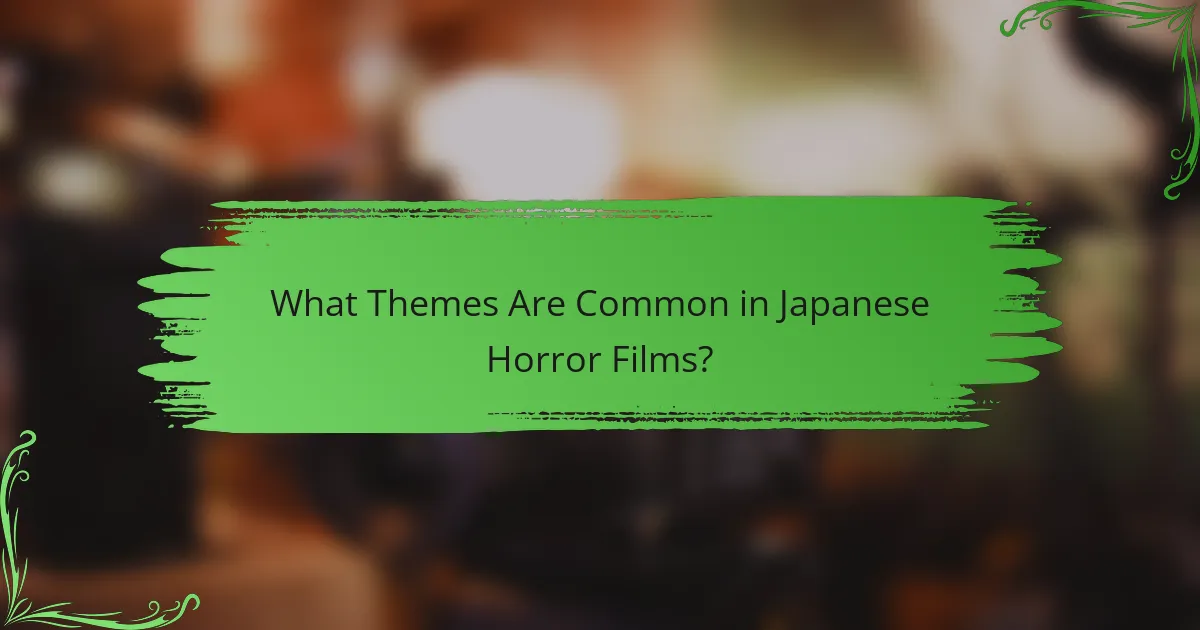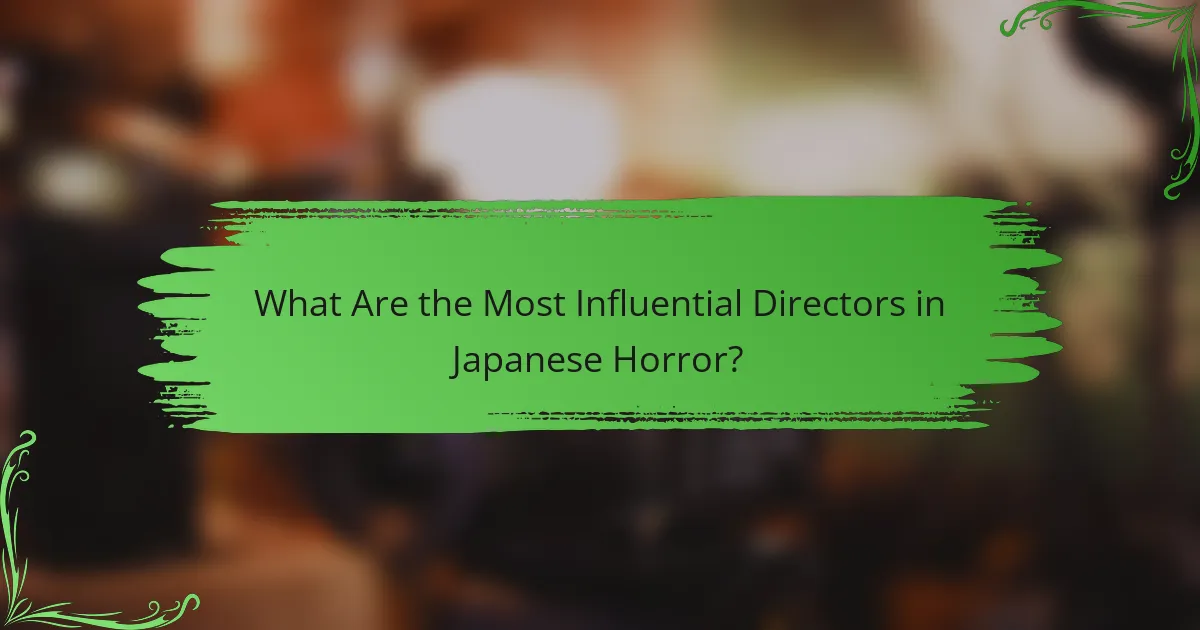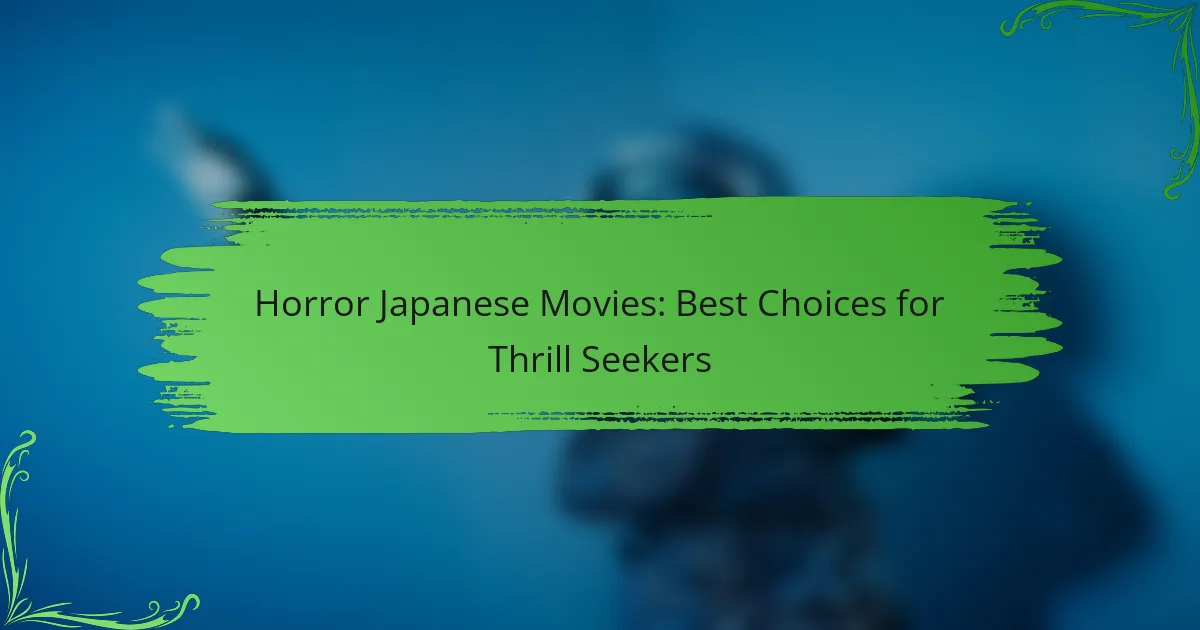For thrill seekers, Japanese horror movies provide a captivating mix of psychological tension and supernatural elements that create an unsettling atmosphere. These films delve into themes of the supernatural and cultural folklore, offering a unique storytelling experience that lingers long after the credits roll.

What Are the Best Japanese Horror Movies for Thrill Seekers?
For thrill seekers, Japanese horror movies offer a unique blend of psychological tension and supernatural elements. The best films in this genre create an unsettling atmosphere that lingers long after viewing.
The Ring (Ringu)
The Ring, known as Ringu in Japan, is a groundbreaking horror film that revolves around a cursed videotape. Viewers who watch the tape receive a phone call with a mysterious voice, warning them they will die in seven days.
This film is notable for its chilling atmosphere and the iconic character Sadako, whose ghostly presence has become a staple in horror cinema. Its influence can be seen in numerous remakes and adaptations worldwide.
Ju-on: The Grudge
Ju-on: The Grudge tells the story of a curse that is born from a violent death, haunting anyone who enters the house where it occurred. The film employs a non-linear narrative, weaving together multiple stories that intersect in terrifying ways.
The film’s unsettling imagery and sound design create a pervasive sense of dread. Its success led to several sequels and American remakes, solidifying its place in horror history.
Audition
Audition is a psychological horror film that explores themes of obsession and deception. The story follows a widower who holds auditions for a film, only to become entangled with a mysterious woman who harbors dark secrets.
This film is renowned for its slow build-up and shocking climax, which leaves viewers questioning the nature of love and trust. It is a must-watch for those who appreciate horror that delves into the human psyche.
Noroi: The Curse
Noroi: The Curse is a found-footage horror film that follows a documentary filmmaker investigating a series of mysterious events linked to an ancient curse. The film’s realistic style enhances the sense of authenticity and dread.
Its intricate plot and chilling atmosphere make it a standout in the genre, appealing to fans of supernatural horror. The film’s slow unraveling of the curse’s origins keeps viewers engaged and on edge.
Dark Water
Dark Water revolves around a mother and daughter who move into a dilapidated apartment building, only to encounter strange occurrences linked to a mysterious water leak. The film explores themes of loss and maternal love, all while maintaining a haunting atmosphere.
Its emotional depth, combined with supernatural elements, sets it apart from typical horror films. The unsettling visuals and sound design contribute to a pervasive sense of unease, making it a compelling choice for thrill seekers.

What Themes Are Common in Japanese Horror Films?
Japanese horror films often explore themes of the supernatural, psychological distress, and cultural folklore. These elements create a unique atmosphere that captivates audiences seeking thrills and chills.
Supernatural Elements
Supernatural elements are a hallmark of Japanese horror, often featuring ghosts, spirits, and otherworldly beings. Films like “Ringu” and “Ju-on” showcase vengeful spirits that haunt the living, creating an unsettling tension. The portrayal of these supernatural entities often draws from traditional beliefs and practices, enhancing their eerie presence.
These films typically use atmospheric settings, such as abandoned houses or dark forests, to amplify the supernatural experience. Viewers are encouraged to engage with the unknown, making the horror feel more personal and immediate.
Psychological Horror
Psychological horror in Japanese cinema delves into the minds of characters, exploring themes of fear, guilt, and madness. Movies like “Perfect Blue” and “Cure” illustrate how psychological trauma can manifest into horror, often blurring the lines between reality and illusion. This approach creates a deep sense of unease, as viewers question what is real.
Character development is crucial in this subgenre, as the audience becomes invested in the protagonists’ mental states. The slow build-up of tension and dread often leads to shocking revelations, making the experience both thrilling and thought-provoking.
Folklore and Mythology
Japanese horror frequently incorporates folklore and mythology, drawing on centuries-old tales and cultural beliefs. Stories of yōkai (supernatural creatures) and kami (spirits) are common, providing a rich backdrop for horror narratives. Films like “Noroi” and “The Grudge” utilize these elements to create a sense of cultural authenticity and depth.
Understanding these folklore elements can enhance the viewing experience, as they often reflect societal fears and moral lessons. Engaging with the cultural context allows audiences to appreciate the layers of meaning in these horror stories, making them resonate on a deeper level.

How Do Japanese Horror Movies Compare to Western Horror?
Japanese horror movies often focus on psychological tension and cultural fears, contrasting with the more graphic violence typically found in Western horror films. This difference in approach leads to unique storytelling and character development that resonate differently with audiences.
Different Cultural Perspectives
Japanese horror reflects deep-rooted cultural beliefs and societal fears, often drawing from folklore and traditional ghost stories. Themes like family honor, the supernatural, and societal pressures are prevalent, creating a distinct atmosphere that may not translate directly to Western audiences.
In contrast, Western horror frequently emphasizes individualism and personal trauma, showcasing monsters or killers as external threats. This cultural lens shapes the narrative and emotional responses elicited from viewers, making each experience unique.
Storytelling Techniques
Japanese horror films often employ slow-building suspense, using atmospheric tension rather than jump scares. This method allows for a gradual immersion into the story, making the eventual horror more impactful.
Conversely, Western horror tends to rely on fast-paced narratives and immediate shocks. While both styles can be effective, the pacing and delivery of fear differ significantly, influencing how audiences engage with the story.
Character Development
In Japanese horror, character arcs often focus on internal struggles and emotional depth, allowing viewers to connect with their fears and vulnerabilities. This approach fosters a sense of empathy, making the horror feel more personal and relatable.
Western horror typically prioritizes archetypal characters, such as the final girl or the monster, which can lead to less nuanced portrayals. While this can create memorable figures, it may not evoke the same emotional resonance as the character-driven narratives found in Japanese films.

What Are the Key Characteristics of Japanese Horror?
Japanese horror is distinguished by its unique blend of psychological depth and supernatural elements, often creating a chilling atmosphere that lingers long after viewing. Key characteristics include atmospheric tension, subtlety in storytelling, and a profound emphasis on the fear of the unknown.
Atmospheric Tension
Atmospheric tension is a hallmark of Japanese horror films, where the environment plays a crucial role in building suspense. Filmmakers often utilize dim lighting, eerie soundscapes, and slow pacing to create a sense of dread that envelops the viewer.
For example, films like “Ringu” and “Ju-on: The Grudge” effectively use silence and minimalistic sound design to heighten anxiety, making mundane settings feel threatening. This tension is often sustained throughout the film, leading to a more immersive experience.
Subtlety and Restraint
Japanese horror often employs subtlety and restraint, avoiding overt gore and shock tactics in favor of psychological horror. This approach allows for a deeper exploration of themes such as grief, loss, and existential dread.
Rather than relying on graphic violence, films like “A Tale of Two Sisters” focus on character development and emotional depth, creating a more relatable and haunting experience. The gradual reveal of horror elements keeps viewers engaged without overwhelming them.
Emphasis on Fear of the Unknown
The fear of the unknown is a central theme in Japanese horror, where the unseen often poses the greatest threat. This concept is prevalent in many films, where malevolent spirits or ambiguous entities create a sense of uncertainty.

What Are the Most Influential Directors in Japanese Horror?
Japanese horror has been shaped by several influential directors who have redefined the genre through their unique storytelling and stylistic choices. Notable figures include Hideo Nakata, Takashi Miike, and Shimizu Takashi, each contributing distinct elements that have left a lasting impact on horror cinema.
Hideo Nakata
Hideo Nakata is best known for his work on the film “Ringu,” which popularized the J-horror genre internationally. His films often explore themes of fear and the supernatural, utilizing a slow-building tension that captivates audiences.
Nakata’s style is characterized by minimalistic storytelling and a focus on psychological horror rather than gore. This approach creates a haunting atmosphere that lingers long after the film ends, making his works essential viewing for horror enthusiasts.
Takashi Miike
Takashi Miike is a prolific director known for his versatility and willingness to push boundaries in horror. His film “Audition” is a prime example, blending psychological tension with shocking violence, which has become a hallmark of his style.
Miike often combines elements of horror with dark humor and surrealism, creating a unique viewing experience. His works can be polarizing, but they are crucial for understanding the evolution of Japanese horror cinema.
Shimizu Takashi
Shimizu Takashi gained fame for directing the “Ju-on” series, which introduced the iconic character of Kayako. His films are known for their non-linear storytelling and chilling atmosphere, effectively building suspense through ghostly encounters.
Shimizu’s approach often involves intertwining multiple storylines, which enhances the sense of dread and unpredictability. His influence on the genre is significant, as his films have inspired numerous remakes and adaptations worldwide.

What Should You Look for When Choosing a Japanese Horror Movie?
When selecting a Japanese horror movie, consider the film’s themes, atmosphere, and cultural context. Look for unique storytelling elements and how they resonate with traditional Japanese folklore and modern fears.
Director’s Reputation
The director’s reputation can significantly influence the quality and style of a horror film. Renowned directors like Hideo Nakata and Takashi Miike have established themselves through distinctive approaches to horror, often blending psychological elements with supernatural themes.
Researching a director’s previous works can provide insight into their storytelling style and thematic preferences. For instance, Nakata’s films often focus on suspense and psychological tension, while Miike is known for his boundary-pushing narratives and graphic visuals.
Consider watching trailers or reading reviews to gauge whether a director’s style aligns with your horror preferences. A director with a strong following may indicate a higher likelihood of producing a compelling film.
